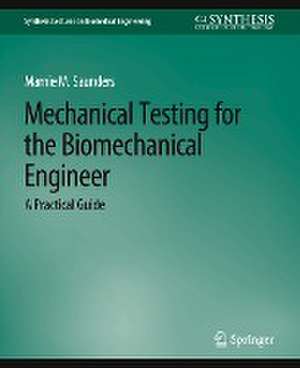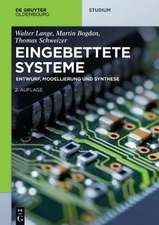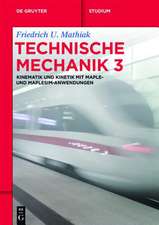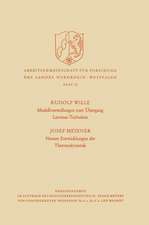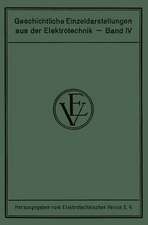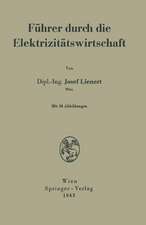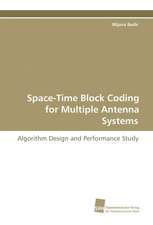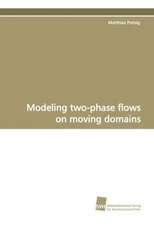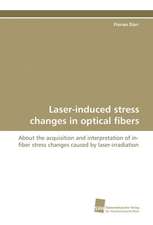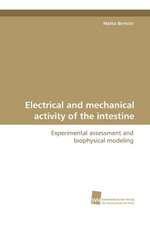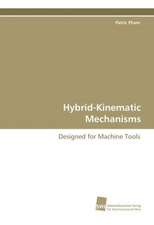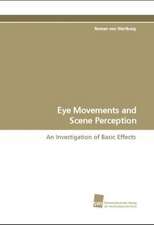Mechanical Testing for the Biomechanics Engineer: A Practical Guide: Synthesis Lectures on Biomedical Engineering
Autor Marnie M. Saundersen Limba Engleză Paperback – 5 ian 2015
Din seria Synthesis Lectures on Biomedical Engineering
- 17%
 Preț: 362.03 lei
Preț: 362.03 lei - 15%
 Preț: 522.24 lei
Preț: 522.24 lei - 5%
 Preț: 364.74 lei
Preț: 364.74 lei - 5%
 Preț: 525.89 lei
Preț: 525.89 lei - 15%
 Preț: 636.80 lei
Preț: 636.80 lei -
 Preț: 382.95 lei
Preț: 382.95 lei -
 Preț: 268.83 lei
Preț: 268.83 lei -
 Preț: 260.77 lei
Preț: 260.77 lei -
 Preț: 266.32 lei
Preț: 266.32 lei -
 Preț: 265.18 lei
Preț: 265.18 lei -
 Preț: 262.47 lei
Preț: 262.47 lei -
 Preț: 204.76 lei
Preț: 204.76 lei -
 Preț: 268.66 lei
Preț: 268.66 lei -
 Preț: 262.47 lei
Preț: 262.47 lei -
 Preț: 206.84 lei
Preț: 206.84 lei -
 Preț: 321.54 lei
Preț: 321.54 lei -
 Preț: 192.05 lei
Preț: 192.05 lei -
 Preț: 261.32 lei
Preț: 261.32 lei -
 Preț: 261.53 lei
Preț: 261.53 lei -
 Preț: 206.84 lei
Preț: 206.84 lei -
 Preț: 349.36 lei
Preț: 349.36 lei -
 Preț: 260.95 lei
Preț: 260.95 lei -
 Preț: 204.76 lei
Preț: 204.76 lei -
 Preț: 268.83 lei
Preț: 268.83 lei -
 Preț: 205.92 lei
Preț: 205.92 lei -
 Preț: 382.57 lei
Preț: 382.57 lei -
 Preț: 346.48 lei
Preț: 346.48 lei -
 Preț: 264.41 lei
Preț: 264.41 lei -
 Preț: 384.48 lei
Preț: 384.48 lei -
 Preț: 259.04 lei
Preț: 259.04 lei -
 Preț: 260.95 lei
Preț: 260.95 lei -
 Preț: 261.32 lei
Preț: 261.32 lei -
 Preț: 158.66 lei
Preț: 158.66 lei -
 Preț: 267.86 lei
Preț: 267.86 lei -
 Preț: 207.65 lei
Preț: 207.65 lei -
 Preț: 205.92 lei
Preț: 205.92 lei -
 Preț: 268.66 lei
Preț: 268.66 lei -
 Preț: 322.31 lei
Preț: 322.31 lei -
 Preț: 205.70 lei
Preț: 205.70 lei -
 Preț: 226.22 lei
Preț: 226.22 lei - 15%
 Preț: 404.48 lei
Preț: 404.48 lei -
 Preț: 263.28 lei
Preț: 263.28 lei -
 Preț: 383.71 lei
Preț: 383.71 lei -
 Preț: 273.45 lei
Preț: 273.45 lei -
 Preț: 207.06 lei
Preț: 207.06 lei -
 Preț: 263.06 lei
Preț: 263.06 lei -
 Preț: 260.77 lei
Preț: 260.77 lei -
 Preț: 205.33 lei
Preț: 205.33 lei
Preț: 391.02 lei
Nou
Puncte Express: 587
Preț estimativ în valută:
74.82€ • 80.01$ • 62.38£
74.82€ • 80.01$ • 62.38£
Carte tipărită la comandă
Livrare economică 17 aprilie-01 mai
Preluare comenzi: 021 569.72.76
Specificații
ISBN-13: 9783031005343
ISBN-10: 3031005341
Ilustrații: XIX, 256 p.
Dimensiuni: 191 x 235 mm
Greutate: 0.49 kg
Editura: Springer International Publishing
Colecția Springer
Seria Synthesis Lectures on Biomedical Engineering
Locul publicării:Cham, Switzerland
ISBN-10: 3031005341
Ilustrații: XIX, 256 p.
Dimensiuni: 191 x 235 mm
Greutate: 0.49 kg
Editura: Springer International Publishing
Colecția Springer
Seria Synthesis Lectures on Biomedical Engineering
Locul publicării:Cham, Switzerland
Cuprins
Preface.- Fundamentals.- Accuracy and Measurement Tools.- Design.- Testing Machine Design and Fabrication.- Fixture Design and Applications.- Additional Considerations in a Biomechanics Test.- Laboratory Examples and Additional Equations.- Appendices: Practical Orthopedic Biomechanics Problems.- Bibliography.- Author Biography.
Notă biografică
Dr. Marnie Saunders is a native of northeast Ohio. She received her B.S. in Mechanical Engineering from The University of Akron in 1991. She completed graduate education at The University of Akron in Engineering (Biomechanics), receiving her M.S. and Ph.D. degrees in 1994 and 1998, re[1]spectively. Under the guidance of the late Dr. Glen O Njus, her graduate research was focused in orthopaedic biomechanics and lower limb prosthetics. In 1998, Dr. Saunders accepted a two-year post-doctoral fellowship at the Pennsylvania State University College of Medicine in Hershey, PA, in the Department of Orthopaedics and Rehabilitation. She split her research efforts between orthopaedic biomechanics and bone cell mechanobiology. Upon completion of her fellowship, she joined the faculty at PSU and remained there for six years working in the Department of Orthopaedics and Rehabilitation conducting research. Presented with the opportunity to teach graduate students, Dr. Saunders accepted a position inthe Center for Biomedical Engineering at the University of Kentucky. She continued her research in bone cell mechanobiology and had the opportunity to transition from orthopaedic biomechanics to craniofacial biomechanics. In 2010 she was given the opportunity to return to her alma mater, The University of Akron, where she is currently an Associate Professor in the Department of Biomedical Engineering. She teaches undergraduate courses in Freshman Design, Musculoskeletal Tissue Mechanics and graduate courses in Bone Biomechanics and Mechanobiology and Continuum Mechanics. She continues her interest and work in design and fabrication of cost-effective, small-scale biomechanical testing platforms, orthopaedic biomechanics, and mechanobiology. Currently her interest is in combining biomimicry and mechanobiology. Her research group is developing in vitro bone cell models that attempt to incorporate key physiologic features to improve research relevance. The models are being used to study how bone cells (osteocytes, osteoclasts and osteoblasts) coordinate their activity in response to alterations in loading environments (microgravity to microdamage). Dr. Saunders has had over $3 million in research support and her research has been funded by The Whitaker Foundation, The National Institutes of Health and The National Science Foundation. She is the recipient of prestigious awards including the NIH NIA K25 Career Development Award and an NSF Career Award. Her current funding includes NSF (Career) and NIH NIDCR (AREA) funding. She is an author/co-author on several research awards (ASBMR, BMES, AAOS, AOA) and while at PSU she received the 2004 Hinkle Society (Rising Faculty Star) Award and a 2005 faculty Mentor Award (Department of Mechanical Engineering). She is an author/co-author on more than 45 book chapters and research publications and over 150 international, national and local research presentations. In 2014, the work of her research group was featured in the journal of International Innovation and she has recently accepted the invitation to serve as guest editor of a biomimicry textbook for Springer Publishing.
